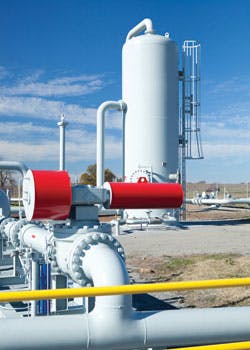It is 1979 and each day thousands of U.S. motorists are waiting in long lines for gasoline. The Iranian Revolution has resulted in lower oil exports and, combined with the Carter Administration's decision to ban Iranian oil imports, panic had ensued over the availability of gasoline. This was not a new situation for U.S. consumers. Just six years earlier, the Yom Kippur War had led OPEC to ban oil exports to countries that supported Israel in the war. By the time the oil embargo ended five months later, gasoline prices in the U.S. had more than doubled.
See Also: The Energy Revolution and US Manufacturing
If there was a lesson from the 1970s for the United States and its citizens, it was that the country was dependent on Saudi Arabia, Venezuela and a host of other nations to slake its insatiable thirst for oil. For the next 40 years, FedEx CEO Fred Smith recently noted, the U.S. has "transferred more wealth… than any entity in history" in order to meet its energy needs.
But jump ahead to November 2012 and it seems almost a case of science fiction that the International Energy Agency (IEA) would issue a report projecting that the U.S. will become "almost self-sufficient in energy, in net terms, by 2035."
What has changed, of course, is one of the most profound technology innovations of the 20th century. Using a process called hydraulic fracturing, or fracking, the U.S. has been able to tap vast new supplies of oil and gas. Sometime around 2020, IEA estimates, the U.S. will overtake Saudi Arabia as the world's largest oil producer and also will see the benefits of greatly improved transportation fuel efficiency. "The result is a continued fall in U.S. oil imports, to the extent that North America becomes a net oil exporter around 2030," IEA expects.
The outlook for natural gas is even more optimistic. IEA forecasts that the U.S. will be a net exporter of natural gas by 2020. And just 10 years later, the agency states, natural gas will become the largest fuel source in the U.S. energy mix.
While such a forecast has caused some observers to discuss a period of "energy independence" for the U.S., many consider that a near impossibility in an interconnected global economy. Anthony Cordesman of the Center for Strategic and International Studies, for example, notes that the U.S. will be importing energy for at least the next decade and will be "dependent on the health of a broader global economy that is becoming steadily more dependent on the security [of] Gulf energy exports." Cordesman also points out that optimistic energy projections "do not adequately consider the wisdom of a 'deplete America first' approach to oil and gas procurement."
The U.S. Energy Information Agency is not quite as bold as its international counterpart, but it too projects a major increase in U.S. energy production out to 2040. However, it also estimates that domestic consumption of energy will continue to rise, though at a slower pace, and that consumption will continue to exceed production.
Currently, there is about a 20% gap between U.S. energy consumption and what the nation can produce. Closing this 20% gap will not be easy, says Michael Peterson, managing director and senior equity analyst on the energy and natural resources research team at investment bank MLV & Co.
"Doubling oil production or cutting transportation demand by 50% would not be enough. Increasing coal or natural gas output by 50%, all for export, would not be sufficient. Reducing demand by 20% within a decade also would not be enough. The point is that progress on each of these fronts will be necessary to balance our portfolio," he explains.
Energy Provides Manufacturers a Competitive Advantage
The energy revolution underway in the U.S. already is having a significant impact on the U.S. economy. Last year, according to an IHS report, unconventional oil and natural gas supported a value chain that accounted for 2.1 million jobs and contributed $283 billion to U.S. gross domestic product. By 2020, IHS estimates the economic benefits will grow to 3.3 million jobs and $468 billion in GDP contributions.
The energy revolution is helping U.S. manufacturers become more competitive. Consider that from 2002 to 2006, energy expenditures by manufacturers rose 29% even though they purchased 15% less energy. But from 2006 to 2010, EIA reports, manufacturers' energy expenditures fell 16% as the amount of energy they purchased dropped just 6%. A major factor in this cost drop: Manufacturers on average saw a 36% decrease in the natural gas price they paid between 2006 and 2010, from $7.59 to $4.83 per million Btu.
"For manufacturers, the relatively cheap price of natural gas is a huge domestic competitive advantage," says Kelly Sims Gallagher, director of the Center for International Environment and Resource Policy at Tufts University's Fletcher School of Law and Diplomacy. "Our competitors in Asia are facing triple or quadruple prices for gas, which they are largely importing."
Marlin Steel Wire Products, a Baltimore manufacturer of wire baskets, reflects the benefits of the natural gas boom for many U.S. manufacturers. The company has seen a 50% drop in its heating bills compared to peak prices a few years ago. President Drew Greenblatt told a House energy subcommittee in June that Marlin Steel's business also had picked up as it sold to companies involved in energy extraction and development such as Schlumberger, Timken and Caterpillar.
"The energy boost is contributing to our own purchases of steel from Indiana and Pennsylvania, to our need to add overtime for our workers in Baltimore, and to our ability to invest in additional automation from robot makers in Illinois and Connecticut to bend wire and cut and shape sheet metal," said Greenblatt.
How important will the U.S. energy advantage be for manufacturers? In a recent report, Boston Consulting Group pointed out that by 2015, the U.S. will enjoy a cost advantage of 60% to 70% for natural gas compared to Europe and Japan, and electricity will be 40% to 70% cheaper than its trading partners.
With its cheaper energy costs, the U.S. can expect to increase exports in seven industrial categories, BCG forecasts, including chemicals, machinery and transportation equipment. For example, BCG projects that the U.S. will gain $7 billion to $12 billion in chemical exports from Europe and Japan. Compared to Germany, chemical production costs in the U.S. will be 29% less expensive by 2015.
"The low cost of U.S.-produced natural gas, an important feedstock in chemicals, will be the big reason," says Justin Rose, a BCG partner.
What will the rise in domestic energy production and manufacturing do to America's enormous trade deficit? IHS projects that the trade deficit will be reduced by more than $164 billion by 2020.
Energy Projects Multiply
Both domestic and foreign firms are investing heavily to support the production of these new energy sources and the subsequent transportation and processing of these products. Louisiana, for example, has announced a string of huge projects in recent months:
• Sasol, an energy and chemicals firm based in Johannesburg, South Africa, has begun engineering and design work on a possible ethane cracker and GTL diesel facility that would cost $16 billion to $21 billion. When completed, the two projects are expected to create more than 1,200 jobs and thousands of indirect jobs.
• Dow Chemical is upgrading its ethylene production capabilities at its Plaquemine site and building two polyolefin plants in a $1.06 billion expansion.
• Dyno Nobel, a subsidiary of Australia's Incitec Pivot, is building an $850 million ammonia plant at the site of Cornerstone Chemical's Fortier Manufacturing Complex. Cornerstone is investing $175 million in upgrades at its facility.
• Benteler International is building a $975 million seamless steel tube manufacturing facility and steel mill with an electric arc furnace. It is the first facility in the U.S. for the Austrian firm.
The scale of these projects reflects the enormity of the changes going on in energy production. For example, the Bakken formation, one of the significant unconventional oil fields, covers approximately 200,000 square miles in North Dakota, Montana, Saskatchewan and Manitoba. In January 2000, the North Dakota and Montana wells produced 61,000 barrels of oil a month. In July 2013, with the widespread adoption of fracking, the area produced more than 25 million barrels of oil. This June, there were 177 oil rigs operating in North Dakota. Just four years earlier, there had been 35.
But while the energy resources are vast, the infrastructure hurdles are daunting. North Dakota remains overwhelmed by the infrastructure needs generated by the emergence of the drilling. Pipelines don't exist to transport the oil from the fields, notes Larry Irving, vice president, Oil and Gas for Emerson Process Management. The oil must be trucked from the wells to terminals and then loaded into railroad tank cars for processing in refineries in Texas.
Drilling for shale oil and gas is also much different and more dynamic than for conventional oil deposits. "Drilling for shale oil and gas is characterized by more of a manufacturing process," Irving said. "I am producing fairly large volumes in year one but then I have a rapid dropoff in production in year two. To maintain the production from year one, I have to drill another well -- and another well."
Emerson provides drilling firms with automation products geared to helping them get wells up and running very quickly. "In a day, we can provide the automation and all the instrumentation they need to understand the operation of that well," Irving explains.
Impact on Renewables
Currently, approximately 6% of the energy consumed in the U.S. comes from solar, wind, geothermal and other nonhydropower sources of renewable energy. While EIA projects that renewable energy production will increase by an average 2.5% through 2040, it says fossil fuels will continue to supply almost 80% of the world's energy use.
For those promoting renewables in the face of climate change, there is concern that more abundant U.S. conventional energy production could result in less investment in renewables.
"It certainly makes it harder for renewable energy," says Matthew Stepp, senior energy policy analyst with the Information Technology and Innovation Foundation. Stepp says renewables previously had to prove they could compete economically with coal. "That has been reset now. You have to shoot for natural gas, which is cheaper than coal."
MLV's Peterson agrees: "Lower natural gas prices, all else being equal, reduce the economic break-even point for renewables and other competing fuels. Effects on the coal market during the new paradigm of natural gas prices [are] instructive, as the market share for coal has declined in the face of lower-priced competing natural gas."
Environmental groups remain wary of natural gas as an answer for America's energy needs. In May, Deborah Nardone of the Sierra Club told a Senate committee: "Best available science shows even with the best controls and requirements in place and enforced, continued reliance on natural gas puts us on a climate trajectory towards disaster. In environmental and climate terms -- natural gas is a gangplank, not a bridge."
| For more on the U.S. energy picture and its impact on manufacturing, check out iw.com/energyoutlook. |
But Rich Cavallaro, president of Skanska USA, said the U.S. is on a journey toward cost-competitive renewable energy. In the short term, the nation needs to pursue oil and natural gas through well-regulated fracking. Cavallaro said the cost to beef up safeguards and allay public fears will not have a significant impact on the industry. "There is nothing in fracking that is technologically impossible," he said.
About the Author
Steve Minter
Steve Minter, Executive Editor
Focus: Leadership, Global Economy, Energy
Call: 216-931-9281
Follow on Twitter: @SgMinterIW
An award-winning editor, Executive Editor Steve Minter covers leadership, global economic and trade issues and energy, tackling subject matter ranging from CEO profiles and leadership theories to economic trends and energy policy. As well, he supervises content development for editorial products including the magazine, IndustryWeek.com, research and information products, and conferences.
Before joining the IW staff, Steve was publisher and editorial director of Penton Media’s EHS Today, where he was instrumental in the development of the Champions of Safety and America’s Safest Companies recognition programs.
Steve received his B.A. in English from Oberlin College. He is married and has two adult children.



